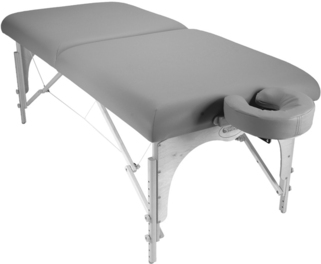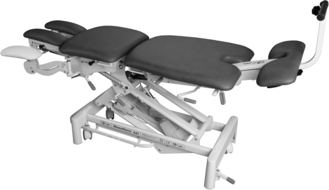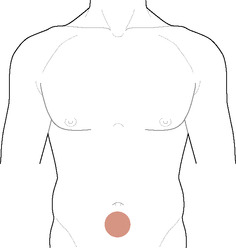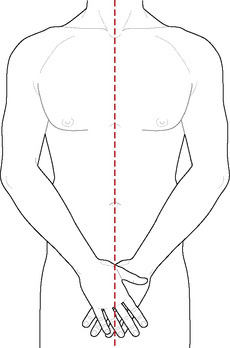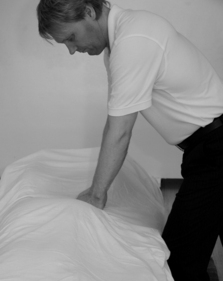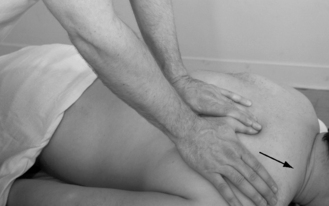2. Work postures, hand placements, and basic massage strokes
As with any form of massage, working with sports massage requires correct work postures and hand placement. It is important to achieve the right amount of power through physical leverage without causing unnecessary stress on the therapist’s body.
Sports massage work postures are generally sourced from the standard “fencing” (Fig. 2.1), and “horse” stance (Fig. 2.2), but must be constantly modified depending on the needs at hand. The stances must generate sufficient leveraged power whilst still feeling comfortable to the therapist.
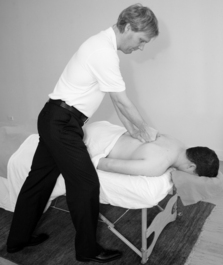 |
| Figure 2.1 |
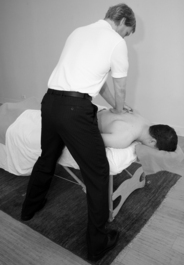 |
| Figure 2.2 |
To achieve more power, it may be beneficial to keep the table slightly lower than normal. Stress on the lower back and legs is minimized by bending the knees and gently leaning on the massage table. Some situations may even require working on the ground, for example preevent stretching of very tall athletes like basketball players, and stances are then adjusted accordingly.
During a sports massage session, whether the treatment table is a portable massage table or a stationary hydraulic version, it must be strong, stable, and ideally be height-adjustable. An adjustable face cradle is also preferable (Fig. 2.3).
During remedial sports massage therapy, the preferred table height will commonly shift during the treatment, and it is more beneficial to use a hydraulic table (Fig. 2.4) than one of fixed height. A sports massage therapist must often improvise and use what is available at the moment, however, and if the table height cannot be changed during a treatment, the techniques have to be adapted accordingly. This can mean that when working with an increased table height, forearms and elbows are preferably used instead of the hands.
Basic massage strokes
Integrated Sports Massage Therapy utilizes a wide range of techniques and massage strokes, but all of them share some common guidelines to achieve proper leverage (Figure 2.5, Figure 2.6 and Figure 2.7). Since the goal is to achieve specific beneficial objectives for an athlete, any massage stroke that can accomplish this may be used. The following is a presentation of a few commonly used massage strokes; see Chapters 6, 9, 10 and 14 for additional strokes employed.
Effleurage strokes
The use of effleurage strokes generally aims to:
• improve circulation by moving venous blood and lymph toward the heart
• increase temperature in the worked tissues
• serve as a good method for a practitioner to palpate the soft tissues whilst massaging and thus continuously facilitate instant adjustments and real-time planning of the treatment.
Effleurage strokes are performed along the venous flow toward the heart. This is especially valid in the extremities to avoid unnecessary stress on the venous valves and walls. Due to their perceived beneficial circulatory effects, it is common to both start and end a sports massage treatment with effleurage strokes to each tended body part. Although basic effleurage strokes are generally viewed as superficial, they can easily be executed with more depth. A faster effleurage is more stimulating whilst a slower application can generate more relaxing effects. Effleurage and friction strokes have shown to beneficially affect post-exercise grip performance after maximal exercise (Brooks et al. 2005).
In preevent massage, it is common to use effleurage strokes, without massage oil, especially when working on “long-term event” athletes. In this case, gliding strokes like effleurage can be applied over sweats, tights, or more commonly, a sheet covering the athlete (Fig. 2.8).
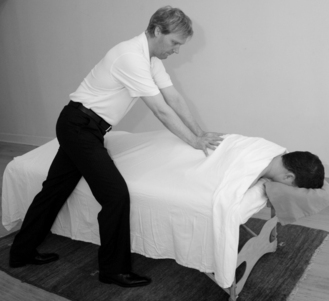 |
| Figure 2.8 |
Regular superficial effleurage(Figs 2.9; 2.10)
1. This stroke is applied with the whole hand but with the majority of the pressure on the palm heel.
 |
| Figure 2.9 |
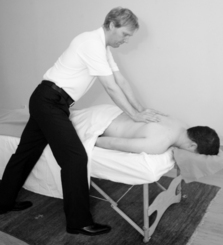 |
| Figure 2.10 |
2. There is an approximately 45-degree angle between the therapist’s arms and the athlete’s body. The angle of the wrists should also ideally be no more than 45 degrees.
3. As the tissue warms up, the depth of the stroke should increase in accordance with the athlete’s needs.
Palm heel effleurage(Fig. 2.11)
1. Palm heel effleurage is slightly stronger than the regular superficial effleurage and employs additional focused pressure with the palm heel of the hands.
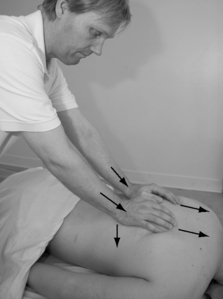 |
| Figure 2.11 |
2. Due to the increased depth, this stroke is executed with a slower speed compared with regular effleurage.
Palm heel and fingertip effleurage(Fig. 2.12)
1. Additional pressure is applied simultaneously with the fingertips; otherwise the execution is similar to palm heel effleurage.
 |
| Figure 2.12 |
2. This stroke is effective when simultaneous deeper palpation is required in an area.
One-sided effleurage(Figure 2.13, Figure 2.14 and Figure 2.15)
1. The hand furthest away from the table is placed superior to the other hand, i.e. when standing on the left side of the table, the left hand is placed superior to the right. The palm heel is fitted between the thumb and index finger of the inferior hand.
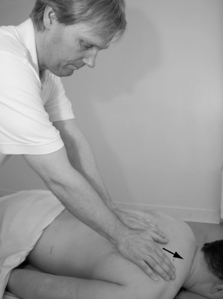 |
| Figure 2.13 |
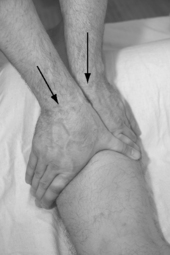 |
| Figure 2.15 |
2. Pressure is applied with the whole hands but with the majority focused on the palm heel.
3. There is an approximately 45-degree angle between the therapist’s arms and the athlete’s body.
4. For added depth, the index and long finger of the inferior hand are placed on top of the thumb to apply extra pressure.
5. To increase pressure and depth during effleurage on legs and arms, the angle of the hands is increased to maximally 45 degrees (see Fig. 2.15).
Forearm effleurage(Fig. 2.16)
1. Forearm effleurage is used on larger areas with more muscle tissue with either one or both forearms.
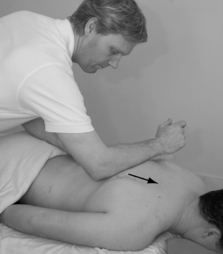 |
| Figure 2.16 |
2. The stroke is performed either simultaneously or alternately depending on preference or need.
3. The angle of the upper arm is placed in roughly 45 degrees flexion to avoid unnecessary stress on the sports massage therapist’s shoulders.
Compression techniques
Compression techniques are perhaps the method most commonly viewed as a typical “sports massage stroke.” The perceived purpose of this stroke is to stretch the muscle and connective tissue fibers in the area by spreading them against an underlying bone, dilate the local blood vessels from the created short-term ischemic effect, and create a pumping action for additional increased blood circulation. Compression techniques are normally executed in a steady frequency of one to three strokes per second. In contrast to effleurage strokes, compression techniques are used in any direction. The strokes are easily administered over clothing or a sheet since no oil or lotion is used.
It is important to execute this stroke in a smooth fashion so as not to risk undesirable discomfort, muscle tension, or injury to the soft tissue. Pain and excess speed can trigger the myotatic reflex and thus increase muscle tension to unwanted levels. Therapeutic awareness is paramount during sports massage.
In areas where there is no direct underlying bone, the therapist’s fingers are temporarily placed on the inferior part of the muscle whilst the palms are compressing the soft tissue from the superior aspect. This application works especially well on muscles like triceps surae.
Caution should be observed over the ribs and kidneys. The lower part of the kidneys lies somewhat more unprotected, and the 11th and 12th ribs are free floating, which consequently makes them more sensitive. This is especially valid if the stroke is applied in an incorrect and forceful manner. The ribs are generally more sensitive in areas where there are fewer muscles to stabilize and protect them.
Compression techniques must be executed in a systematic fashion to achieve maximal effect. The strokes are applied to one specific area of the body at a time, until signs of relaxation and increased circulation are observed.
Palm compression
Double-handed palm compression(Fig. 2.17)
1. One hand is placed on top of the other at a 90-degree angle.
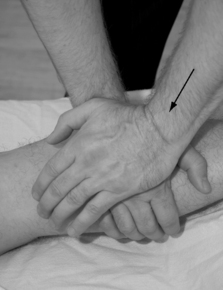 |
| Figure 2.17 |
2. As the therapist leans forward, the palm heel smoothly compresses the muscle toward an underlying bone until resistance is felt.
3. The pressure is subsequently released as the therapist leans away.
4. The stroke is repeated in a selected area until an effect is observed.
5. The stroke smoothly and systematically covers the entire length of the treated muscles.
Single-handed palm compression(Fig. 2.18)
1. This compression stroke is executed alternately with two hands.
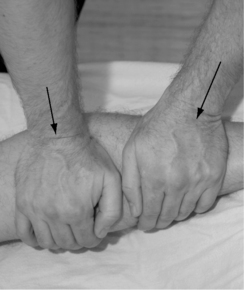 |
| Figure 2.18 |
2. The direction of the downward pressure is applied obliquely to eliminate unnecessary stress on the wrists. The amount of flexion in the wrists should ideally be 45 degrees, which eliminates much of the strain.
Fist compression(Fig. 2.19)
1. One of the main benefits of fist compressions is that the wrists are kept straight to minimize stress on the joints. The massage stroke is executed with the thumbs facing anterior to maximize the biomechanical benefits.
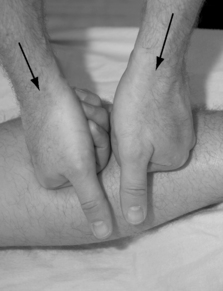 |
| Figure 2.19 |
2. Fist compressions are initiated with the main pressure placed on the second and third knuckles (index and long finger) and their proximal phalanges.
3. As the pressure increases, a slight radial deviation is applied to smoothly roll the pressure toward the fifth finger. This slight roll enables a smoother transition between the hands, and feels more comfortable to the athlete. The fists are kept fairly loose to create an even contact surface.
Thumb compression(Fig. 2.20)
1. One thumb is placed on its side to avoid unnecessary stress on its joints. The thumb will merely function as a passive tool.
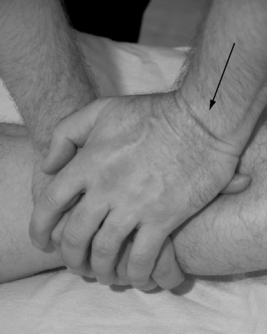 |
| Figure 2.20 |
2. The heel of the palm of the other hand performs the actual stroke by compressing muscle and connective tissue toward underlying bones through the thumb.
3. Thumb compressions are normally used in smaller areas where regular palm or fist compressions may be difficult to use, or between muscle bellies and larger fascias. The stretch effect increases if additional lateral force is applied at the end section of the stroke.
Elbow compression(Fig. 2.21)
1. This stroke is mostly used over areas with denser muscle tissue and/or when the intent is to affect more deeply situated muscles.
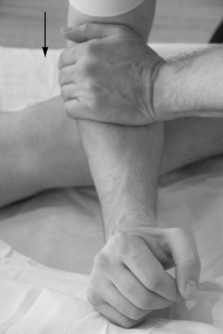 |
| Figure 2.21 |
2. Different parts of the elbow can be used to make the stroke more or less specific.
3. Added horizontal pressure, as the muscle warms up, will also increase the stretch effect in the treated soft tissue.
Forearm compression(Fig. 2.22)
1. Forearm compressions are beneficial to use on thigh, arm, and larger back areas.
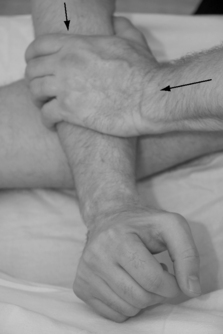 |
| Figure 2.22 |
2. A slight additional rolling motion with the forearm gives this stroke a softer quality.
Broadening(Figs 2.23; 2.24)
The broadening stroke is a combination of muscular compression and a lateral gliding pressure that generates a stronger manual stretch. Broadening is normally performed in three different ways:
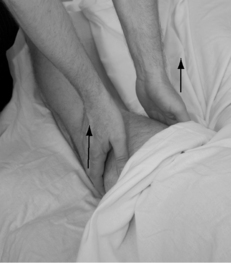 |
| Figure 2.23 |
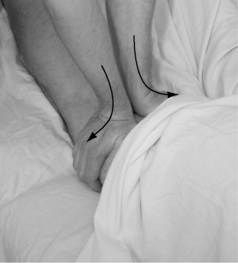 |
| Figure 2.24 |
• heel of the palm of the hands
• thenar eminence
• elbows.
1. For larger muscles, the palm heels are placed in the middle of the muscle belly/group with the palmar side of the wrists facing and almost touching each other.
< div class='tao-gold-member'>
Only gold members can continue reading. Log In or Register to continue
Stay updated, free articles. Join our Telegram channel

Full access? Get Clinical Tree



